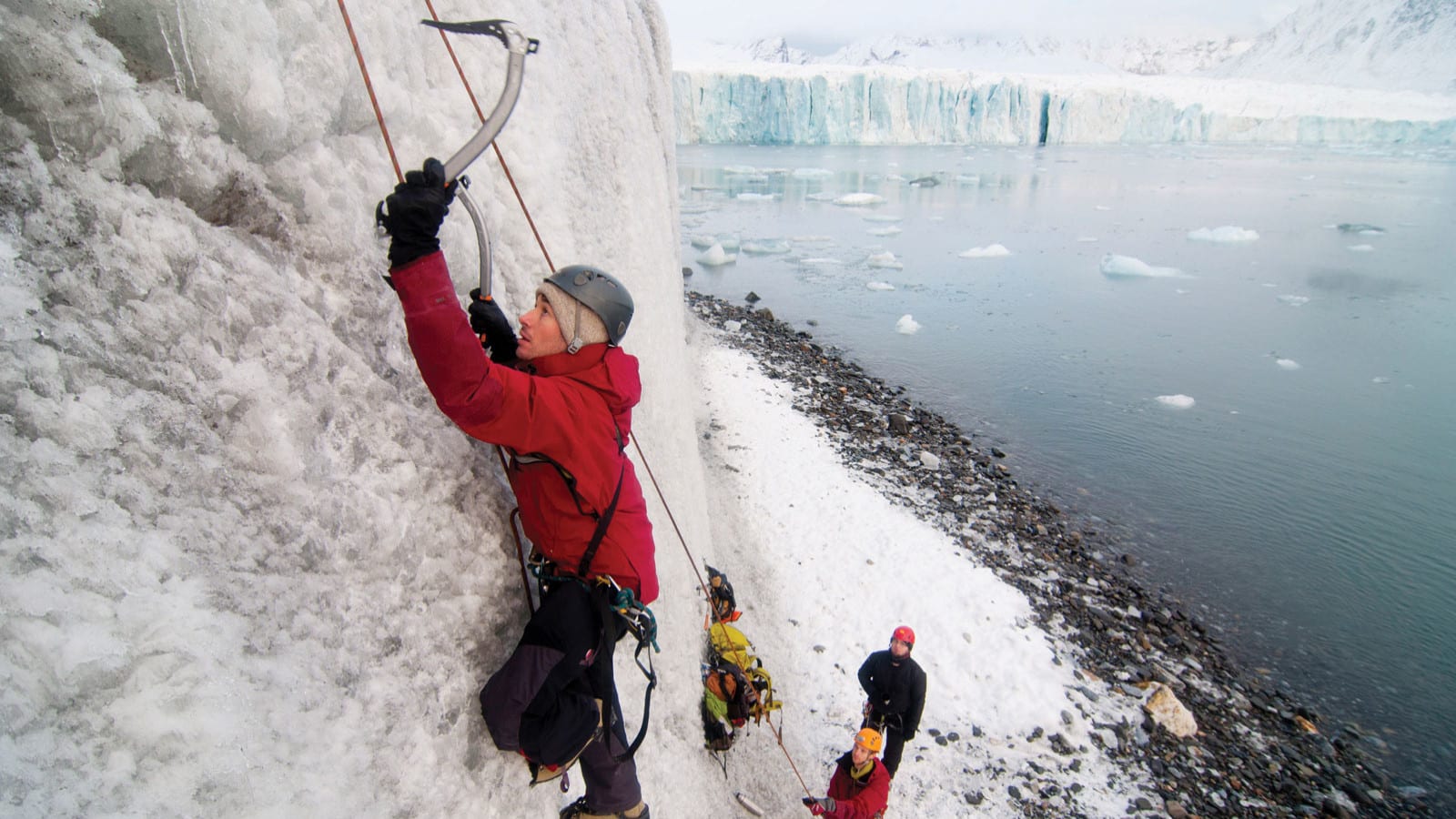As an eyewitness to an unfolding global catastrophe, Ken Mankoff ’96 studies the impact of climate change on polar regions.
Ken Mankoff has truly seen the world. An earth scientist specializing in polar glacier hydrology and oceanography, he has given presentations on all seven continents, from the U.N. General Assembly room to the Amundson-Scott South Pole Station, and made some 25 research expeditions to Antarctica, Greenland, Svalbard, Alaska, Iceland, Norway, and Switzerland, presenting his findings in papers with titles such as “Subglacial Conduit Roughness: Insights From Computational Fluid Dynamics Models.” And if traversing the Earth’s surface were not enough, Mankoff would love to see the planet from space: He applied to be an astronaut for both NASA, in 2016, and the European Space Agency, in 2008 (he has U.S., Swiss, and Italian citizenship), advancing to the final NASA round.
Today, Mankoff witnesses the world melting. A senior scientist in the Department of Glaciology and Climate for the Geological Survey of Denmark and Greenland, he uses high-tech sensors and robotic devices to gather data about glaciers and ice sheets, documenting their decline in response to climate change. It’s a process that Mankoff was drawn to in part because of the planetary consequences. “What is the biggest change we’re going to see in our lives?” he asks. “Sea level rise—that’s one. A hundred years from now, when you look down from space, the coastlines will look different.”
And while he notes that, from a societal perspective, the resulting global disruption will be catastrophic, the earth scientist in him wishes he could witness it firsthand. “I don’t like people dying, but I love a good natural disaster,” he explains. “I’ve been in the eye of a hurricane—those things are fascinating. I’m not going to get to see this one, but we all know people who are alive today who will be alive in 80 years. And if there’s a meter of sea level rise, most cities in Florida will be uninhabitable.”
Mankoff, who when not on or under an ice sheet lives with his wife in Seattle, grew up in the suburbs outside New York City, attending a Waldorf school and Burke Mountain Academy before arriving at Williston for his junior year. He recalls racing on Mount Tom as a member of the school ski team, and taking classes in physics—“playing with Slinkies to learn about springs and the mathematical equations that teach you how to determine the wave propagation”—and in English, where he honed the writing skills that he now uses for his numerous scientific papers.
After Williston, Mankoff attended the University of Colorado Boulder, where he studied computer science and was part of the first all-student team to develop and launch a space satellite. After graduating in 2001, he studied microtechnology and robotics at École Polytechnique Fédérale de Lausanne in 2003 and earned his Ph.D. in earth and planetary science at the University of California, Santa Cruz, in 2013. His career has included positions at NASA, the Woods Hole Oceanographic Institution, the American Museum of Natural History, and various universities. “I view myself as basically doing the job I’ve been doing since 1998, which is a scientific programmer working with any earth science data set. It’s changed from space, to weather, to oceanography, to now cryosphere and glaciers. But it’s all kind of the same thing.”
Granted, his work environment has changed over the years: He now spends months at a time in some of the harshest conditions on Earth, making sure his team has everything it needs to accomplish its mission and return alive. “I’m not an adrenaline junkie and I don’t like risking my life, but at the same time, you’re at the edge of where you’re supposed to survive, and it requires really nice teamwork. I don’t like sleeping next to a big gun and having to worry about polar bears. But when you come back, and it all worked out, it’s a really good feeling.”
One recent project left Mankoff with a particularly good feeling. In September 2017, an Airbus A380 en route to Los Angeles from Paris was crossing over southern Greenland when one of its four engines blew apart. The plane, the industry’s largest with more than 500 people on board, landed safely in Canada, but investigators wanted to recover a key missing engine piece—the fan hub—to determine what caused the failure. Mankoff was sent to find it.
Locating a 450-pound chunk of titanium buried in a moving sheet of ice, in one of the planet’s more remote environments, would require inventing a mobile metal detector and developing new exploratory procedures, a process that ultimately took six expeditions, various airborne radar assessments, sensor prototyping in Zermaat, Switzerland, and countless hours of effort by teams on multiple continents. (Mankoff tells the story in a paper published in April in the Journal of Glaciology.) When the fan hub was finally found, it happened to be in the middle of a field of snow-covered crevasses, where the wrong step could send a person plunging to their death. Mankoff’s team, roped off for safety, used shovels, chain saws, an electric winch, sleds, and a gasoline heater to pull the part from its 15-foot-deep hole—21 months after it had fallen from the sky.
“It was the most fun project I had ever worked on,” says Mankoff, noting that a French team is making a documentary about the project. “Glaciology is all about what might happen a hundred years from now. But this mattered now and today.” Indeed, finding the part helped investigators determine the cause of the engine failure, in turn leading to inspections of the other A380 engines in service. “So it was an important part to find, and hopefully we have saved some lives,” Mankoff says. And, he adds, “I didn’t have to think about climate change.”

